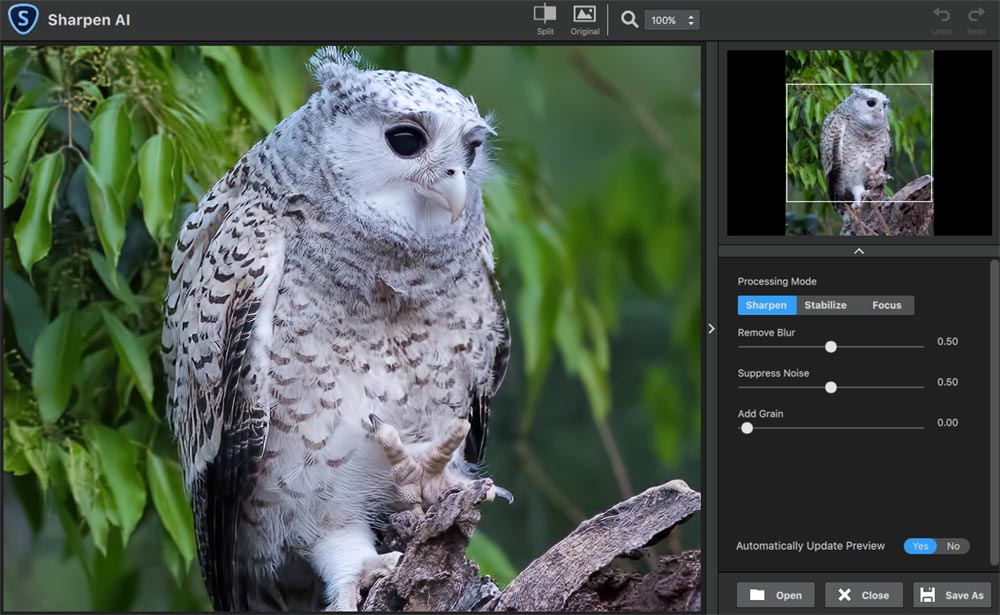
But that still leaves only an RGB file of some format to feed the Sharpen AI. I understand the process for editing the RAW image file as a separate copy without Denoise processing then copying the LR edits from that file to the Denoised (using the RAW model) DNG output file. Lightroom and Sharpen AI will only have the Topaz DNG file to work on …… ? As I understand it, this isn’t a true RAW file and it’s therefore not possible to feed the noise-processed file AS A RAW FILE to the Topaz sharpening engine or to Lightroom. Is it (or will it be) possible to employ RAW processing mode for both Denoise AI and Sharpen AI on the same image during the same workflow? At present, it seems that I can feed a RAW file to Denoise, as the first workflow step, but the output can at best be only the Topaz DNG file. Here’s a short video showing the new features of the Comparison View. That involves sending a TIFF copy to DeNoise AI and use the improved Comparison View to choose the best model and settings. If the edited RAW file isn’t affected by excessive noise, I’ll follow my typical workflow of using Lightroom’s “Edit in DeNoise AI” option. The next step is to sync the edits I made to the original RAW file to the DNG file and apply tweaks to match them up. I will then apply the RAW model, save the file, and import the newly created DNG output file back in Lightroom. If the photo suffers from excessive noise, I’ll create a virtual copy or a new snapshot and send the unedited RAW file to DeNoise AI. Once I am close to wrapping up the edit, I’ll take a close look to see how much noise is affecting the photo. My workflow involves editing my “Pick” RAW files using Adobe Lightroom Classic first. Not every RAW photo needs to be sent to DeNoise AI at the beginning of your post-processing workflow. The real question worth asking is IF you should use the RAW model, and the answer is a bit more nuanced. That’s when to use the RAW model, and you have to use supported RAW files. Fortunately, the answer is straightforward: you should use the RAW model at the very beginning of your post-processing workflow.
#Denoiser 3 how to use update#
I spent a lot of time reviewing all of the comments left on our DeNoise AI v3.3 update post and our social media channels, and one of the most common themes-and source of confusion-has to do with when to use the RAW model. I recommend reading this article to learn more about how and why we built the RAW model. Both of these file types are classified as compressed RGB files, and while DeNoise AI can do great things with them, there is so much more that we can do when we source the original RAW data.

This workflow requires your DAM first to create a duplicate file, often a JPEG or TIFF. Typically, you’d import your RAW files into your digital asset manager (DAM), go through a curation process, edit your picks, and then send the noisier ones to DeNoise AI. We’ve also loved seeing the noise-reduced photos you’ve shared with us online! We built the RAW model to deliver the cleanest possible noise reduction by changing the data we analyze. T he denoised images are saved in the output directory, now postfixed by "_denoised".We’ve been thrilled with all the positive (and constructive) feedback on the new RAW model recently introduced in DeNoise AI v3.3. This will start the denoising process based on the settings that you have chosen. Choose whether you want to denoise a single frame or a sequence and then select 'Denoise'.

Choose a rendered _Noice_Input EXR image in the Input and a directory for the output (denoised) files.They are named after the beauty filename, postfixed by "_Noice_Input". Alongside your beauty file (id enabled), Arnold will save an EXR version of it, also containing the AOVs needed for denoising. Ensure that you are rendering out to EXR.You won't see these AOVs listed on the AOV tab, but they will be added to the rendered output. This will automatically generate the normal, depth and albedo AOVs required for the Arnold Denoiser.

Go to the Denoiser tab and enable Output Denoising AOVs under Arnold Denoiser.The Arnold Denoiser parameters are only available when using Production rendering (not ActiveShade).The Arnold Denoiser requires that the parameter "Output Denoising AOVs" is enabled before rendering in the render settings ( Denoiser tab).


 0 kommentar(er)
0 kommentar(er)
